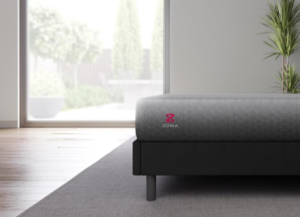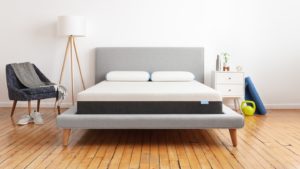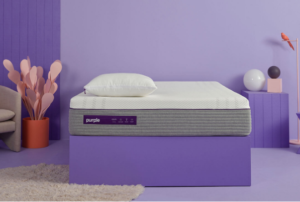If you suffer from hip pain, you’ve likely tried everything while searching for relief. While this might make you feel hopeless, you are not alone. Results from a National Health and Nutrition Examination Survey found more than 14 percent of respondents reported having hip pain.
One solution you may not have tried is changing your mattress. The right mattress can alleviate the pressure off your hips, providing relief. This, in turn, can provide more restful sleep, improving the overall quality of life. It’s the finding of such a mattress that can be a little complicated.
Below, you’ll find our editors’ recommendations for mattresses that help with hip pain. You will also find a guide to help you understand the causes of such pain and tips on how to deal with it better.
Quick View: The Best Mattresses for Hip Pain
Editors’ Recommendation: Amerisleep AS3
Best Memory Foam Mattress: Zoma Mattress
Best Mattress On Amazon: Vaya Mattress
Recommendations of mattresses for sleepers with hip pain
| Type | Firmness | Price | Sleep Trial | Warranty | |
| Amerisleep AS3 | Partially plant-based memory foam | Medium | $1399 | 100 nights | 20 years |
| Zoma Mattress | Open-cell memory foam | Medium | $850 | 100 nights | 10 years |
| Vaya Mattress | Open-cell Vaya foam | Medium | $595 | 100 nights | 10 years |
| The Bear | Memory foam | Medium-Firm | $800 | 100 nights | 10 years |
| Original Purple Mattress | Gel-infused foam and poly-foam | Medium-Firm | $1099 | 100 nights | 10 years |
1. Amerisleep AS3
 The AS3 from Amerisleep is a versatile, partially plant-based mattress designed to suit most types of sleepers. It blends support and pressure point relief, so it’s ideal for sleepers with hip pain.
The AS3 from Amerisleep is a versatile, partially plant-based mattress designed to suit most types of sleepers. It blends support and pressure point relief, so it’s ideal for sleepers with hip pain.
The mattress starts with a soft-to-the-touch, lightweight cover. Its properties promote airflow and prevent night sweats.
Below the cover is the Bio-Pur® layer. It is more breathable than traditional memory foam because this high-density foam has increased air space between its particles. Bio-Pur® also returns to its original shape faster than traditional memory foam beds. This improves the mattress’s motion isolation and response time.
Next is the Affinity layer with Harnessing Intelligent Ventilation & Energy (HIVE®) technology. It’s firmer under your torso to prevent sinkage and softer under your shoulders and hips for deeper compression.
Finally, there is the base Bio-Core™ layer, designed with longevity and durability in mind. Plus, the AS3 is CertiPUR-US® certified, meaning it’s free from harmful chemicals and low in VOCs.
Amerisleep offers a 100-night sleep trial with a 30-night break-in period. The company also offers a 20-year warranty on issues related to the quality of materials and craftsmanship. If anything goes wrong in the first decade, the mattress can be replaced free of charge. If anything goes wrong during the second decade, the company will cover you on a prorated amount, based on how long you’ve owned your bed.
Key Features
- Thickness: 12 inches
- Cushioning: Plant-based Bio-Pur® memory foam
- Warranty: 20 years
- Sleep Trial: Risk-free, 100 nights
2. Zoma Mattress
 If your hip pain comes from living an active lifestyle, you’ll want to check out the Zoma Mattress. Zoma Sleep designed this comfortable mattress specifically with sportspeople in mind.
If your hip pain comes from living an active lifestyle, you’ll want to check out the Zoma Mattress. Zoma Sleep designed this comfortable mattress specifically with sportspeople in mind.
The cover of the Zoma Mattress is made from a blend of 97% polyester and 3% spandex. It’s breathable, stretchy, and soft to the touch.
The top layer holds the company’s unique Triangulex™ technology within the gel memory foam. Made from hundreds of triangular cutouts, this zoned design provides targeted support to the pressure points.
Next comes the Reactiv™ layer. This latex-like poly-foam design is responsive and reduces motion transfer. Last comes a thick, high-density support layer, that helps to relieve hip and shoulder pain.
The 100-night sleep trial for this mattress comes with free shipping and returns. The 10-year warranty covers full product repair or replacement against workmanship and structural defects.
Key Features
- Thickness: 10 inches
- Foam: Gel memory foam with Triangulex™ design
- Warranty: 10-year warranty
- Sleep Trial: 100 nights
3. Vaya Mattress
 Next on our list is the budget-friendly Vaya Mattress, brought to you by Vaya Sleep. Vaya Sleep is a relatively new mattress brand, offering just one bed, but we like them because they make the mattress shopping process very simple. With Vaya, you have one mattress to consider. If it works for you after the adjustment period, great! If it doesn’t, that’s okay too, as the Vaya comes with free returns.
Next on our list is the budget-friendly Vaya Mattress, brought to you by Vaya Sleep. Vaya Sleep is a relatively new mattress brand, offering just one bed, but we like them because they make the mattress shopping process very simple. With Vaya, you have one mattress to consider. If it works for you after the adjustment period, great! If it doesn’t, that’s okay too, as the Vaya comes with free returns.
The Vaya Mattress is designed to feel medium in firmness, so it offers a good mix of comfort and support. We recommend this mattress for those with hip pain because it offers a lot of responsiveness, so while it relieves pressure and pain in the hips, it also keeps your hips lifted in a comfortable position.
The Vaya only has two layers, a comfort layer of contouring Vaya Foam and a core layer of sturdy base foam to resist sagging. As an online mattress brand, Vaya offers a 100-night sleep trial and a standard 10-year warranty with their mattress, too.
Key Features
- Thickness: 12 inches
- Foam: Vaya foam
- Warranty: 10-year warranty
- Sleep Trial: 100 nights
4. Bear Mattress
 The Bear is a medium-firm mattress, designed with athletes in mind. The muscle-restoring memory foam design of the layers works great for people with hip pain as well.
The Bear is a medium-firm mattress, designed with athletes in mind. The muscle-restoring memory foam design of the layers works great for people with hip pain as well.
The mattress starts with a cover that holds Celliant® technology. This is an infrared yarn design that promotes active muscle recovery by increasing local blood flow.
Next comes a cooling graphite-gel memory foam, which dissipates heat and contours the body. Bear claims this foam can keep you up to seven times cooler when compared to traditional memory foam.
Below the graphite-gel memory foam comes the responsive transition foam. It offers support to the spine and pressure point relief.
Finally, the last layer within the Bear mattress is a high-density support foam. This is the base layer that supports the structure of the mattress.
Bear offers a risk-free 100-night sleep trial with a 30-night break-in period. The 10-year warranty covers sagging greater than 1 inch, cracked memory foam, or any other manufacturing defects.
Key Features
- Thickness: 10 inches
- Foam: Graphite-gel memory foam
- Warranty: 10-year warranty
- Sleep Trial: 100 nights
5. Original Purple
 The Original Purple Mattress is known for its unique Purple Grid™ technology. If you’re looking for a “floating sensation” when sleeping at night, this bed is for you.
The Original Purple Mattress is known for its unique Purple Grid™ technology. If you’re looking for a “floating sensation” when sleeping at night, this bed is for you.
First, Purple encases the mattress in a SoftFlex Cover. This cover is extra stretchy so it can flex along with the Purple Grid™. It’s also very soft to the touch and breathable.
Next comes the 2-inch Purple Grid™ with Balanced No-Pressure® Support. This contouring layer adjusts to your pressure points by collapsing under pressure. The grid has more than 2,500 open-air channels that can also help to reduce body heat when sleeping.
The bottom of the mattress is made from a dual-layered comfort foam. They are both responsive, yet soft enough to improve pressure point relief.
The Original Purple Mattress comes with a 100-night risk-free trial. However, there is a 21-night compulsory break-in period.
The company also offers a 10-year warranty for sagging greater than 1 inch and any other manufacturing defects.
Key Features
- Thickness: 10 inches
- Foam: Purple Grid™
- Warranty: 10-year warranty
- Sleep Trial: 100 nights
Common Causes of Hip Pain
Changing your mattress could help you relieve some of your hip pain. But it’s also well worth your while to try to identify the root cause of the pain. Consider visiting a trusted healthcare professional who can help you determine the exact reason. Odds are, your hip pain is caused by one of the conditions listed below.
Arthritis
There are various types of hip arthritis, although osteoarthritis is the most common. According to the American Academy of Orthopaedic Surgeons, more than 28 million people have osteoarthritis, which is known best as “wear-and-tear” arthritis. The hip is prone to osteoarthritis because it is a weight-bearing joint. Although osteoarthritis most often occurs in those older than 50, it’s also possible for younger people to suffer from it as well.
The hip joint is a ball-and-socket joint protected by cartilage. The cartilage wears away with continual use, at which point it becomes frayed and rough. When there is less cushion between the “ball” and the “socket” of the hip joint, it causes bone-on-bone contact. The bones rubbing against one another is what causes pain and potential inflammation.
Although you can develop osteoarthritis at any time, there are a couple of things that increase your likelihood of it happening. These include:
- Old age
- A family history of osteoarthritis
- Previous injuries to the hip
- Obesity
- Developmental dysplasia of the hip, which is when the hip doesn’t form properly at birth
Bruising
If you’ve recently suffered a fall or an injury, there’s a strong chance you’re suffering from some form of hip bruising. It occurs when tiny blood vessels, known as capillaries, break, causing minor bleeding under the skin. Depending on the force of the injury, you may also damage the surrounding tissues as well. This, in turn, can cause inflammation and even stiffness.
The most apparent sign of bruising is the discoloration of the skin. Bruising can also cause your muscles to spasm when you try to move because the muscle tissue is swollen and inflamed.
Hip Bursitis
The hip joint has tiny, fluid-filled sacs known as bursas. Their job is to provide cushioning to the joint. When bursa sacs become inflamed or irritated, pain is often the result. This is known as trochanteric bursitis.
Trochanteric bursitis can be caused by an injury, such as falling on the hip. Or it can develop over an extended period of time with activities like standing for too long or with incorrect posture.
Typically, you’ll feel bursitis pain on the outside of the hip or thigh. There will also be a sharp pain when lying on the affected side or when you press on the affected area.
Cancer
One of the rarer causes of hip pain is bone cancer. The American Cancer Society estimates that around 3,500 people will be diagnosed with bone cancer this year, accounting for less than 0.2% of all cancers.
The most common cancer found in the hip is chondrosarcoma. It tends to grow on flatter bones like the hip or shoulder. Another common type of hip cancer is metastatic cancer. This type of cancer is often found in bones in the middle of the body, including the hip. This malignant tumor can quickly spread from one bone to the other.
If you find your hip pain is mild to moderate, try treating it with over-the-counter anti-inflammatories. Heat or ice can also help with the swelling and pain. If this does not relieve your symptoms of chronic pain, you may want to visit a doctor for further testing.
Fractures
Doctors classify hip fractures as breaks in the upper quarter of the femur bone. They most often occur as the result of a fall, especially in individuals older than 65. Elderly patients tend to have weaker bones due to conditions like osteoporosis, stress, and cancer. If the bone is particularly brittle, it can break by merely standing on the leg and twisting in the wrong direction.
A hip fracture is different from most other fractures. Hip fractures can be life-threatening. Doctors cannot use a cast to treat a hip fracture. Instead, fractures require surgery and physical therapy. This can be especially challenging when working with older patients.
Infections
Infections occur when bacteria, viruses, parasites, or fungi enter the bone and reproduce. The most common type of bone infection is caused by a bacterium known as Staphylococcus aureus. Most infections are typically accompanied by severe pain, but they are easily treatable by medication.
Labral Tear
As mentioned, the hip is a ball-and-socket joint. There is a piece of soft tissue, known as the labrum, covering this joint. The labrum assists the “ball” part of the hip to move smoothly in the “socket.” However, the labrum is also prone to tearing, which can cause considerable pain.
One of the most common causes of labral tears is structural ailments. For example, femoroacetabular impingement — where the femoral head doesn’t fit into the socket as it should. The impingement can limit mobility, cause pain, and eventually cause the labrum to tear. If left untreated, this condition could also lead to osteoarthritis.
Injuries are another common cause of labral tears. Typically, athletes participating in sports with repetitive, high-impact movements are most prone to labral tears. Sometimes symptoms of labral tears include pain, feeling unsteady on your feet, and a clicking or locking sound when you move the hip. Other people may not have any symptoms associated with their labral tear at all.
Muscle and Tendon Strains
There are many muscles that run through the hip area. If you stretch one of these muscles beyond its limit or tear it, you’ll have suffered a muscle strain. Muscle strains can be mild, moderate, or severe. Most strains heal with rest, although severe strains may need physical therapy or other medical treatment to heal.
The tendons in the hip joint can also get strained. They are the tough tissues that connect muscles to bones. Once you’ve strained a tendon or muscle, there’s an increased likelihood that you’ll injure it again.
Muscle Tightness
If you struggle to identify the cause of your hip pain, it may simply be muscle tightness. This is usually the case if X-rays or MRIs of the hip come back without an identifiable problem. This is because muscle tightness is not usually visible on an MRI or an X-ray. That does not mean that the problem does not exist though.
The hip flexors are a group of prominent muscles running through the hip. When these muscles become shorter, it can be quite painful.
A sedentary lifestyle involving sitting at a desk all day is one of the primary causes of hip flexor pain. Additionally, tight quadricep muscles (a group of four large muscles on the front of the leg) could also result in tight hip flexors.
Tight hip flexors could also cause lower back pain. Hip flexors can cause a muscle known as the iliopsoas to tighten. This muscle runs from the hip up through the lower back. If this muscle is tight, your hips will shift downward and forward, causing your lower back to form a “C” shape. This is known as anterior pelvic tilt, which can also be quite painful.
Of all of the conditions on our list, this is the one that’s most likely to be caused by poor mattress selection. For instance, if you’re a stomach sleeper and you sleep on a bed that’s too soft, your hips will sink into the bed, over-activating your psoas and throwing your hips out of alignment. A mattress designed explicitly for your preferred sleeping position will provide the needed pain relief.
Osteonecrosis of the Hip
As the American Academy of Orthopaedic Surgeons explains, “osteonecrosis of the hip is a painful condition that occurs when the blood supply to the head of the femur (thighbone) is disrupted.” If left untreated, osteonecrosis can lead to severe arthritis and other degenerative conditions in the hip joint. Osteonecrosis is most common in people between 40 and 65, with men being more prone to this condition than women.
Doctors aren’t always able to pinpoint the exact cause of osteonecrosis. But it often occurs due to injuries, such as a hip fracture or dislocation. Another suspected cause is the use of corticosteroid medications.
Pinched Nerve
Your central nervous system is an intricate roadmap of nerves running through your entire body. Nerves are responsible for letting your brain know when there is pain. If the tissues in the hip press on a nerve, the nerve will become “pinched” or “stuck”. This can cause significant pain, tingling, and even weakness. Pinched nerves can flare up every now and then due to:
- Sitting for extended periods
- A poor sleep position
- Pregnancy
- Arthritis
- Muscle strain
- Bone spurs
- Being overweight
A more severe version of a pinched nerve is known as sciatica. The sciatic nerve is a large nerve running from your lower back down through your leg. Often, you’ll feel the pain from this injury in your hip, even though the “pinching” may be taking place in another place, like your lower back.
Tendinitis
Tendinitis is an overuse injury that occurs when the tendons in the hip are inflamed. Tendinitis pain tends to develop over time, gradually getting worse. Typically, hip degeneration is a sign of tendinitis. Rest, stretching, and making efforts to relieve pressure points can all help ease tendonitis pain.
Quality Sleep and Hip Pain
If you have long suffered from chronic hip pain, you may overlook your mattress as being one of the causes, but a bed can impact hip pain in two ways.
First, a wrong mattress could impact hip pain by not allowing you to achieve high-quality sleep in general. When you sleep, your body heals itself and recovers from injuries. If you’re not sleeping soundly every night, you prevent this process. Small problems, like slight muscle strains, or inflammation can grow into more significant issues if you don’t allow your body to recover.
Recent studies show a link between sleep disruption and pain severity. The NCBI explains that “a trend has emerged suggesting that sleep disturbance may be a stronger predictor of pain than pain of sleep disturbance .”
Secondly, there could be a direct correlation between hip pain and your sleeping habits. If you don’t have the right mattress for your sleeping position, you could be making your pain worse.
Start by considering your sleeping position. These are the three most common sleep positions, and each is best served by a different mattress firmness level to maintain spinal alignment.
Back Sleepers
Back sleeping is a healthy pose for the back and hips since you’re sleeping in a neutral position. Back sleepers need a mattress to keep their body in a healthy position—a bed that’s too soft will make your hips sink low, and you’ll end up sleeping in a “U” shape.
Back sleepers will also want to make sure they have a compatible pillow, too. Pillows that are too thick or too thin will cause the neck to fall out of alignment.
Side Sleepers
Side sleepers will benefit most from a softer bed. If you sleep on a firm mattress, the shoulders and hips can develop pressure points, and this can cause the middle of your spine to sag down in a “V” shape. Side sleeping in a softer bed allows the hips and shoulders to sink in a bit, so the spine remains neutral.
Side sleepers will also want to choose the right pillow to keep their neck in alignment with the rest of the spine. Depending on how broad your shoulders are, you may need to use one or two firm pillows to elevate your neck to the correct height.
Stomach Sleepers
Stomach sleepers will want to look for a bed with a firm sleeping surface. They can use a very soft pillow, or perhaps no pillow at all. This way, the head lays directly on the mattress, so there is no strain on the neck. Additionally, stomach sleepers will want to consider putting a pillow underneath their abdomen or pelvis to lift the hips up and keep them in alignment.
Things to Consider When Buying A New Mattress
If you haven’t shopped for a new mattress in years, you may be overwhelmed by the number of buying options available. Not only can you buy a new bed in a store, but you can also purchase a bed-in-a-box online. Below are some of the things you’ll want to consider when buying a new mattress.
Firmness
As previously mentioned, different mattresses have varying levels of firmness. You’ll want to choose the mattress which best matches your sleeping position and body type.
For instance, those who sleep on their backs and need full-body support won’t want an ultra-soft bed with a pillow-top. A good mattress will provide proper weight distribution, spinal alignment, and support to the body’s sensitive areas. There should not be much sinkage and your body weight should be supported at all times.
Mattress Materials
There are three main materials manufacturers use to make today’s beds—memory foam, innerspring, and latex. Each type is similar but also offers unique features.
Innerspring mattresses used to be the most popular type, but they have grown a bit outdated. Now, innerspring coils are most commonly used as a feature in hybrid mattresses. Hybrid mattresses mostly use pocketed coils, which is the latest and most adaptable coil design. When integrated with latex or memory foam, they provide an effective support system for most sleepers.
Latex mattresses tend to last longer and are more responsive. They are mainly made from 100% organic latex and come with a much heftier price tag. For people with hip pain, a latex mattress can potentially be a good choice. However, they don’t usually have a zoned support system. This can be an issue, depending on the cause of your pain.
Memory foam mattresses are known to provide the best contouring and pressure point relief. They mold around the sleeper’s body and take the weight off the pain points of the body.
Memory foam can also make you feel trapped, as its response time is not always great. This can be an issue for people with pain, since changing sleeping positions can become a hassle.
Sleep Trials and Warranties
Most bed-in-a-box brands offer sleep trials and warranties. You’ll want to consider both when determining whether a mattress is worth the investment.
A sleep trial is a period you can use to try the bed. Most sleep trials last around 100 nights. If you decide that you don’t like the mattress during this time, you can usually return it free of charge. The terms do vary from brand to brand though, so always do your research first.
Mattress warranties have become much more extended since manufacturers have shifted to foam and latex. These materials are designed to last. Make sure your mattress comes with a 10-year warranty at least, if not longer. Do ensure to read the fine print as well, as the terms and conditions can be very different for each mattress.
Ways to Relieve Hip Pain
Although most types of hip pain are chronic, there are steps you can take to make the pain feel more bearable. Here are a few suggestions that might provide you with some relief:
- Change Your Mattress — As discussed above, sleeping on the correct mattress can help with hip pain. If your mattress is old and worn out, you will not be getting enough support and pressure point relief. Think about the date your current mattress was purchased. If it has been more than a decade, you should definitely consider investing in a new, better-suited bed.
- Change Your Sleeping Position — Sleeping on the stomach puts a lot of stress on the neck and back and tends to cause pain. Side sleepers and back sleepers may have more luck alleviating their hip pain since their spine will be in a more neutral position.
- Use a Pillow Between Your Knees — Another trick to relieve chronic hip pain is to sleep with a pillow between your knees. Doing so can reduce the pressure that causes pain. You can also use extra pillows for pressure relief in other parts of the body, including places like the knees, lower back, or pelvis.
- Low-Impact Exercise — Gentle exercise encouraging whole-body movement helps to increase blood flow. It also lengthens muscles, which reduces the build-up of lactic acid. If your hip pain is caused by a strained muscle, this could effectively help with the pain. If your injury is more serious, then avoid exercising unless your doctors say otherwise.
- Use a Pillow Topper — If you’re looking for a more temporary solution to help you wake up pain-free in the morning, consider using a mattress topper. Manufacturers often make mattress toppers with memory or latex foam, which can provide a layer of support for your old bed.
This article is for informational purposes and should not replace advice from your doctor or other medical professional.